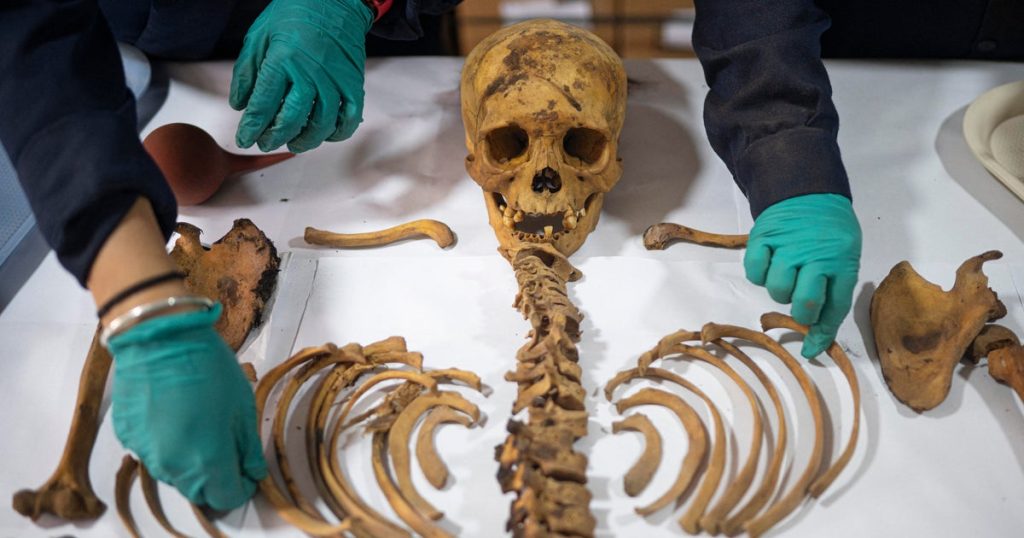Recently, Peruvian utility workers made an extraordinary archaeological discovery while installing pipes in Lima, unearthing a 1,000-year-old mummy. The find highlights the presence of pre-Hispanic tombs in the region and offers a glimpse into ancient burial practices. Archaeologists indicated the remains likely belonged to a boy aged between 10 and 15, shedding light on the cultural and historical significance of the Chancay civilization that thrived in the area.
| Article Subheadings |
|---|
| 1) Discovery of the Mummy |
| 2) Archaeological Significance |
| 3) The Chancay Culture |
| 4) Archaeological Protocol in Peru |
| 5) Recent Discoveries in Peru |
Discovery of the Mummy
On June 19, 2025, during routine installation of gas pipeline infrastructure, workers encountered an unexpected archaeological site in the Puente Piedra district of northern Lima. At a depth of approximately 20 inches, the crew discovered the remains of a young boy believed to be aged between 10 and 15. The find was officially confirmed by Jesus Bahamonde, an archaeologist and the scientific coordinator at the Cálidda utility company. He reported that the trunk of a huarango tree, a species native to coastal Peru, served as a marker for the tomb.
The body, which was positioned in a seated posture with bent arms and legs, was draped in a shroud accompanied by calabash gourds, indicating it was part of a burial practice. The unearthed remains, referred to by archaeologists as mummies, are reminiscent of burial customs that prevailed in ancient cultures along the Peruvian coast.
Archaeological Significance
This recent finding underscores Peru’s extensive archaeological heritage, which includes over 500 sites across Lima alone. The burial style and artifacts found alongside the mummy indicate that it dates back to the Chancay culture, which flourished between the 11th and 15th centuries. Jose Aliaga, another archaeologist involved in the excavation, noted that the mummy still had dark brown hair, providing valuable insights into the past.
The ornate ceramic objects discovered nearby—featuring geometric designs and symbols of fishermen—further reinforce the cultural connections to the Chancay civilization. These artifacts offer a glimpse into daily life, spiritual beliefs, and the artistic expressions prevalent during that era.
The Chancay Culture
The Chancay civilization was an influential pre-Inca society known for their advanced craftsmanship and intricate artwork. They existed during a period marked by significant cultural exchange among coastal societies in ancient Peru. The community’s unique burial practices, often involving elaborate tombs such as the one recently discovered, reflect their beliefs in an afterlife and the importance of honoring their deceased.
Archaeological studies indicate that the Chancay people participated in extensive trade networks, resulting in a rich blend of cultural influences. Their pottery, which featured vivid colors and elaborate motifs, is among the most celebrated of pre-Columbian art. Understanding these artifacts enhances our awareness of Peru’s diverse history and the interconnectedness of ancient cultures.
Archaeological Protocol in Peru
In Peru, the discovery of archaeological remains during construction projects mandates the involvement of qualified archaeologists to assess and document the findings. This protective measure is crucial due to the nation’s rich history and the ongoing risk of losing significant cultural heritage. The Cálidda utility company, since its inception, has reported over 2,200 archaeological finds since 2004, reflecting a commitment to honoring Peru’s past.
This protocol is designed to mitigate the impacts of modern infrastructure development on cultural sites, ensuring that historic remains are preserved rather than destroyed. Given the frequency of such discoveries along the Peruvian coast, it is vital for utility companies and authorities to adhere to archaeological guidelines during excavation processes.
Recent Discoveries in Peru
This discovery is not an isolated event; the past months have seen a string of significant archaeological finds in Peru. In April of the current year, archaeologists announced the discovery of 5,000-year-old remains of a noblewoman at the sacred site of Caral, known for its historical importance but previously ignored due to its use as a garbage dump for decades.
Additionally, days prior, excavation efforts uncovered an ancient tomb containing the remains of two dozen individuals, speculated to be battle victims, further illustrating the depth of Peru’s archaeological wealth. These finds not only reveal the region’s storied past but also highlight the ongoing efforts to excavate and study ancient sites that may offer keys to understanding pre-Columbian civilizations.
| No. | Key Points |
|---|---|
| 1 | Utility workers in Lima discovered a 1,000-year-old mummy while installing pipes. |
| 2 | The mummy is believed to be that of a young boy, found in a seated position. |
| 3 | The discovery reflects the cultural practices of the Chancay civilization. |
| 4 | Peruvian law mandates archaeological oversight during construction projects. |
| 5 | Recent archaeological finds in Peru highlight the country’s rich historical landscape. |
Summary
The uncovering of a 1,000-year-old mummy in Lima by utility workers underscores the importance of preserving Peru’s rich archaeological heritage. This discovery not only contributes to the understanding of the Chancay civilization but also emphasizes the need for careful archaeological practices during modern development. As recent excavations continue to reveal significant historical findings, the commitment to cultural preservation remains crucial in safeguarding Peru’s timeless legacy.
Frequently Asked Questions
Question: What was found during the pipe installation in Lima?
Utility workers discovered the remains of a 1,000-year-old mummy believed to be a boy aged between 10 and 15, along with artifacts linked to the Chancay culture.
Question: Why are archaeological protocols important in Peru?
Archaeological protocols ensure that significant heritage sites are preserved during construction projects, allowing for the documentation and study of invaluable historical artifacts.
Question: What do recent discoveries in Peru indicate about its history?
Recent discoveries enhance understanding of Peru’s rich pre-Columbian history, showcasing the cultural practices and lifestyle of ancient civilizations.


